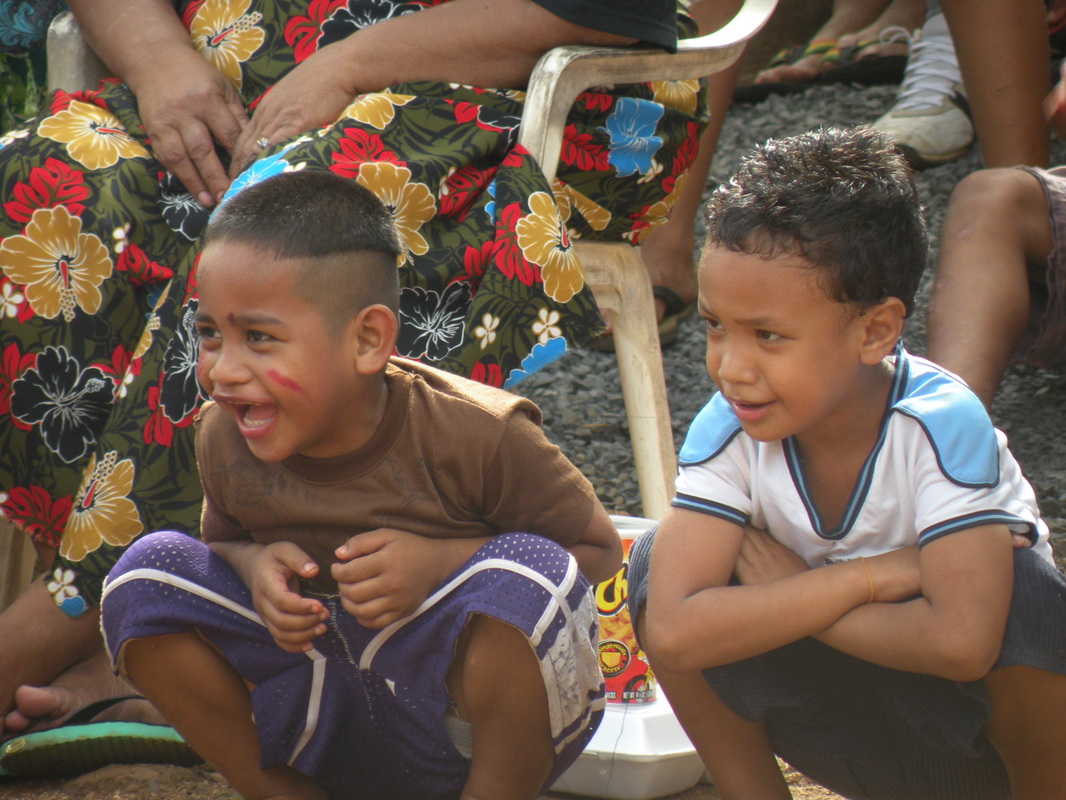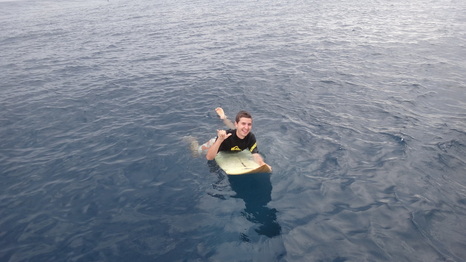 A few minutes before I entered the world's largest washing machine Looking at my past posts, I haven’t written much about what I’ve done outside of work for a while. Well, I got a story from this morning. I’ve always wanted to learn to surf. Being an East Coast guy I haven’t been presented with many opportunities and hoped I would get the opportunity to catch some waves here in Pohnpei. As the old phrase goes, be careful what you wish for. Pohnpei has a world-famous surfing spot known as Palikir Pass. It doesn’t produce the biggest waves in the world but is renowned for creating perfect barrels. That said, the waves can still get pretty big! I first went surfing a few weeks ago. As I have never even seen surfing up close I stayed on the outside at the beginning and watched how it was done. When I finally thought I’d give it a shot there were many surfers in the water and I didn’t want to take the waves of people who had traveled thousands of miles to surf here. I got hit by a decent size wave and tumbled through the water once, but it wasn’t too bad. Then today happened. We got there around 7:30 and I knew from the last time I wanted to be aggressive and try to catch a wave early before more surfers came. I almost caught one but backed up when I realized it was too big. I had an inkling I was in “over my head” (pardon the pun) but I didn’t want to call it a day after only a few minutes. The waves were much bigger than my first surfing experience. It was at this point I saw that I was too shallow and was right in the place where most of the waves break. A set was coming any minute so I started to paddle out of there. It was then I saw Ben, a MAHI volunteer who is working as a doctor in the State Hospital, wave me over to the inside. Uh-oh: a set was coming. I only got a few feet before I saw Ben drop in on this MONSTER wave. I froze. I didn’t want to get in his way. By that point it was too late anyways. There I was, a huge wall of water, at least 10 feet high, about to break right on me. When I think 10 feet high, I think of a basketball hoop. That’s not that high, right? Well I realized later on that in surfing you’re on the “ground.” Next time you’re next to a basketball hoop, lie on the ground and picture a wall of water as high as the top of the backboard about to crash down on you! At this point, any thoughts of the beauty of being in the barrel were quickly overwhelmed by an all-consuming sense of fear. I don’t think there’s a human being in the world who wouldn’t be scared in that moment! Before I knew it I was in the world’s largest washing machine being tossed around like a rag doll. It was at this point I remembered John telling me a story of him getting crushed after dropping in on a monster wave and getting a quick breath of air before being pummeled again. I got a quick breath of air, along with some salt water, before getting swept away by another massive wall of white water. This is when it got a little scary. For those who don’t know, you wear a leash on your ankle which is attached to the back of the board, so you don’t lose your board in situations like this. Despite getting some air before the second wave, I was out of breath and still under water. Then the leash got tangled around my neck. My board was being pulled along with the wave just like me. I don’t know how, but by the grace of God I got some super human strength and managed to pull the leash off my neck. The ocean showed no mercy. I got another quick breath, along with some more salt water, before being consumed again. At this point I felt like a dead fish. I was completely out of breath, energy and adrenaline. Some scary thoughts entered my mind of potential consequences if this barrage didn’t end soon. After the third sweeping I felt some coral on my feet. This was a relief but a bit concerning at the same time. I knew that any severe consequences, i.e. drowning, were unlikely as I could stand on the reef, but at the same time I knew the coral was likely to inflict some damage. Two more walls of whitewater came and my legs and feet got cut up pretty bad, but that was the least of my concerns. I was just happy to finally be out of the worst of it. Getting pummeled by waves is nothing new to surfing, especially to rookies. My friend Kohei came to see how I was doing and could see the fear in my eyes. The whole leash strangling deal was a bit alarming. Apparently it doesn’t happen very often and my concern was warranted. The currents were pretty strong and Kohei helped navigate me back to the boat. Later on Kohei somehow convinced me to get back in the water, though this time I went without a surfboard and with fins. I wanted to get some close up pictures with my waterproof camera, which you can see below, along with a video! FYI, the wave in the video is about half the size of the wave that crushed me, to give you some perspective. I would just like to say that this obviously wasn’t my brightest moment! Sometimes you don't know what you're getting into until it's too late. I still want to learn to surf, but what I did today was skip the bunny hill to try double black diamond. Live and learn._ We’re still in the thick of it in our education program. The work is difficult and tedious but worthwhile. I’m excited this week that I will be starting a new internship at the College of Micronesia! More information on that to come!
 A little blurry, but it's not exactly ideal conditions to take pictures! Let's leave it to the professionals:
 A devastated home in the lower 9th Ward - Six years after Katrina __ Last year at this time I spent spring break going on a service trip with my college to New Orleans, spending a week rebuilding homes. During the trip we kept a group journal which was later typed up and sent to everyone. I thought I would revisit the trip a year removed from the experience. The words I wrote jumped off the page. Before I explain why, here are a couple excerpts: March 13, 2011 Today during our large group reflection a common theme was the frustration over government inefficiency in solving the many problems presented in the city. Ultimately what it boils down to is the current state of the city, and particularly its education system, simply is not good enough. As a nation we need to hold ourselves to a higher standard – the wealthiest nation in the world should not have desolated communities such as the ones we saw today. While perhaps this is a bit idealistic, I am hopeful that we as a generation, and as engaged Dickinsonians, can work to improve these communities by attacking flawed, corrupt systems of oppression and implementing innovative and comprehensive policies to create lasting change. This is a broad idea in theory however, as it is abundantly clear that these problems are complex beyond our comprehension. I found myself dumbfounded today to see homes completely refurbished that would fit well into any normal neighborhood, surrounded by abandoned homes, clearly destroyed by the storm. While we all will learn a lot during our time here, I believe it is important to recognize that our understanding of the problems facing New Orleans and the effects of Hurricane Katrina will always be limited. We can hear survivor’s stories, see the destruction and experience the culture, but we will never be able to fully comprehend what this city and these people have gone through. It is with this approach of humility that I hope to attempt to grasp the infinitely complex problems presented, all the while doing my best to lend a helping hand. This week we will be making a small contribution to rebuilding New Orleans by repairing homes. However, I believe the lessons we all learn and the experiences we all have this week will lead to a changed mindset, forever reminding us of the desperate need for compassion and understanding in this world. March 17, 2011 A strong focus of this trip has been actively reflecting on our experiences. While I believe this is a valuable activity, something I have learned is how the most valuable reflections have come after much time has passed. It can take weeks, months, and even years to learn all the lessons from one specific trip or experience. I’m sure that my reflections of this trip will continue to grow and change as time distances itself from this moment. While New Orleans and Pohnpei are on the opposite ends of the globe, it has become abundantly clear that many of the problems facing these developing communities are the same. In my journal entry, along with many of the others written by my classmates, it was cited how frustrating it is to witness government inefficiency and lack of action. Well, if you thought American bureaucracy can be a headache, you haven’t been to Pohnpei! The fact that I then went on to specifically state how the “education system simply isn’t good enough” made me laugh considering what I have been doing the past five months. Looking at what I wrote, I see a fundamental shift in my approach to social change. Specifically, this sentence stood out: “While perhaps this is a bit idealistic, I am hopeful that we as a generation, and as engaged Dickinsonians, can work to improve these communities by attacking flawed, corrupt systems of oppression and implementing innovative and comprehensive policies to create lasting change.” I read this now and shudder. Even if you look back to my October and November posts, I used this type of language. Let's dissect it: It is well written, and uses several big words and phrases when it comes to social change like “systems of oppression,” “innovative and comprehensive,” and “lasting change.” I read it and it sounds very appealing – who wouldn’t want to attack “systems of oppression,” being “innovative” to create “lasting change?” Here’s my point: it’s all talk. When the rubber hits the road, big sentences like this might sound good, and maybe help people open their wallets to support whatever cause, but it doesn’t do anything. It’s not necessarily wrong to talk like this, but if it’s not supported with action, it doesn’t do anything but inflate the ego of the speaker. When it comes to social change, especially in developing communities, it is essential that the leaders are men and women of action. I’m really happy though that I followed up that “big” sentence with acknowledging that it is “abundantly clear that these problems are complex beyond our comprehension.” I knew when I went to New Orleans for only a week that I would not even start to slightly understand the problems that the communities there are facing. I thought however after spending five plus months on this tiny isolated island in the middle of the Pacific I would begin to grasp how to address the many problems on the island. Today I found myself saying, “The longer I stay here the more confused I get at how we can help this place.” I think that whenever attempting community reform we will find ourselves saying something similar to this. There are just so many factors – culture, government, race, education, history, religion – the list goes on and on. From New Orleans to Pohnpei, Somalia to Lima, Peru, Afghanistan to Sierra Leone, the difficulties in bringing “lasting change” to a developing community are vast and remarkably complex. There are no silver bullet solutions, despite how tempting it might be to search for them. I have become more and more convinced however, as evidenced in my last post, that when tackling any type of social change, the best and most effective approach is not attempting to reform a government policy or institution. Rather, it is to take an individual approach, working with the members of the community, learning how as an outsider you can best serve them in their efforts to better themselves and their community. This is a much less attractive approach – it doesn’t have the glitz and glamor of “fighting systems of oppression” and it certainly is much more difficult than finding the silver bullet solution. But in the end what’s most important? I look back a year ago in my week in NOLA with fond memories of friendships that were strengthened and created and being surrounded by like-minded peers who chose to attempt to grasp the complex problems of the world for a week rather than having fuzzy memories of a night on some beach. We left an indelible mark on the communities where we served, making them one step closer to recovery. We weren't working to reform vast institutions. Instead, we worked to help individuals, serving them the best way we knew how. As far as the future of New Orleans goes, I’m sure that most of us can look back at our time there and conclude that we learned a lot but ultimately left with more questions than answers. This struggle persists and always will. There is no utopia, no happily ever after. However, I have been taught by several individuals, and have come to believe, that there is always hope. I know this is cheesy but let me explain. I’m reading a biography on Abraham Lincoln, entitled “Team of Rivals: The Political Genius of Abraham Lincoln” by Doris Kearns Goodwin. In the book, Goodwin describes how Lincoln was “acutely aware of his own emotional needs,” finding rejuvenation and relief in several ways from the overwhelming burden of leading America through its most perilous years. Goodwin goes on to reference Daniel Goleman’s study on emotional intelligence which states, “Having hope means that one will not give in to overwhelming anxiety, a defeatist attitude, or depression in the face of difficult challenges or setbacks. [Hope is] more than the sunny view that everything will turn out all right, [it is] believing you have the will and the way to accomplish your goals” (631). Goodwin then writes, “More clearly than his colleagues, Lincoln understood that numerous setbacks were inevitable before the war could be brought to a close. Yet in the end, he firmly believed the North would prevail.” All those in the field of social change, especially those working in developing communities, could learn from Lincoln and his emotional intelligence. While there will inevitably be countless challenges and a never-ending stream of questions, if we have hope we are armed with the power to make a difference. And that is needed everywhere in the world, from New Orleans to Pohnpei.
 Students in an overcrowded classroom at Sekere Elementary working on reading comprehension worksheets
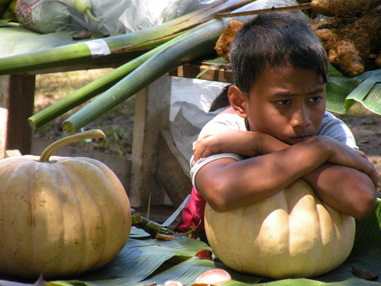 _ Way back in October I e-mailed my college president, Dr. William Durden, asking for any general advice in our education efforts here in Pohnpei. While he provided plenty of great advice the quote that stands out in my mind is “Reform must come from within and cannot be imposed.” I took this to heart and throughout our efforts to reform the education system on Pohnpei, I have been constantly searching for how we can motivate the students, teachers and administration to excel. We have informed the students of their extraordinary position of privilege, talked with teachers about their struggles and paths to improvement, and reported to administrators the severe deficiencies we have found in the classroom. Ultimately though, I’m still left wondering what we can do to encourage the majority of the locals to improve the education system. We can help in many ways but as Dr. Durden wisely noted, we can’t force motivation upon them. I have learned firsthand the need to understand a people before you can “change” them in any way, shape or form. You don’t have to go that far back in Pohnpeian history to see that their current lifestyle is vastly different from the past. Before the white man ever arrived on island, the Pohnpeians were largely living a very comfortable life. They didn’t work a 9-5 job, doing the same thing every day of the workweek. Instead, they were mostly sustenance farmers, living off the land. Pohnpei is known as the “Garden Island” of Micronesia. All three other states of the FSM, Yap, Chuuk and Kosrae, have more difficulties in growing food and have to worry about water collection. Food is abundant in Pohnpei and water is one of the least of their concerns. A few examples illustrating Pohnpei’s “Garden Island” title: - In November we were eating papayas here at the MAHI International Hospitality Center and tossed the seeds off the balcony. There are now ten papaya trees, the tallest being seven feet tall.
- Mr. B told me that the old canoes found in Pohnpei were not designed for the open ocean. The fish were so abundant inside the reef they didn’t need to go outside of it. The canoes found in Yap, Chuuk and Kosrae however were all designed for the open ocean.
- All throughout Pohnpei there is so much food that is waiting to be harvested. Everywhere there are Giant Taro patches, Breadfruit, Coconut, Banana and Papaya trees, and much more.
Living with such plentiful resources produced a unique lifestyle on Pohnpei. While they still had to work, the transition to the typical Western work life has been very difficult. Throughout our time in the schools I have asked every class if the students have been off the island before, and only a handful that were born off island answered yes. It’s worth noting that every time we have encountered a student who is clearly far ahead of their classmates, we have discovered they came from Guam or the US. Every student who was born on Pohnpei has never left. How are we supposed to motivate these students to excel in their education so they can go to college, if they have never been outside of this tiny island? What we’re ultimately trying to do here in Pohnpei is not just reform the education system, but influence the culture so that reform is possible. As Dr. Durden noted, our real challenge is “cultural resistance and cultural change.” How does one begin to change a culture? Is that a desirable goal in the first place? The fact is that much of Pohnpei’s culture has been lost due to the pervasive Western influence. Many of their traditions have not been completely lost, but perverted. A great example of this is sakau. Previously, sakau was a ceremonial drink that was only drank by the high traditional leaders on very special occasions. Now it is drank by over 70% of the islanders daily. It’s crystal clear that it is ridiculously difficult to reform a culture and the deeply entrenched institutions that lie therein. Given this, I have sought to influence individuals, believing that if even one student is positively impacted by my being here, my time will have been well spent. Institutions and certainly a culture are simply too large to tackle, especially in the short-term. While the vision of grand change might be admirable and worth seeking, at the end of the day what we’re seeking to change are individuals. Only the local people can shape their culture. Indeed, reform must come from within.
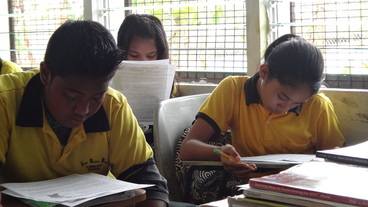 Students at Sokehs Pah Elementary _ I remember in college I would begin each semester imagining myself conducting a perfect academic symphony – reading all material twice, completing all assignments early, breezing through exams, and writing an amazing, well-researched final paper. While I did well in school, my symphony was never on the level of Mozart or Tchaikovsky. Indeed, once the semester got underway it was always harder than imagined to maintain momentum. Semester after semester I learned the same lesson. I know I’m not the only college student, past or present, who can identify with this story. When I came to Pohnpei I remembered the lesson. I still envisioned a symphony – working with principals and shaping them into better leaders, exposing teachers to new techniques, motivating students to commit themselves to their education – all in an effort to make a deep and lasting change on the education system in Pohnpei. This time though, I knew it wasn’t going to be a smooth ride. Right now we are in the thick of it. We are teaching in the schools every week, working to improve our program and building for the future. As you might have gathered through past posts, we face our fair share of obstacles every day here in Pohnpei. Several times we have pulled up to an empty school due to a funeral or an unfamiliar holiday. Perhaps our largest obstacle that I have hinted to in my previous two posts is the teachers’ lack of English skills (see picture below). Given obstacles like these, it’s not surprising that each of us has asked “Can we really make a difference here?”
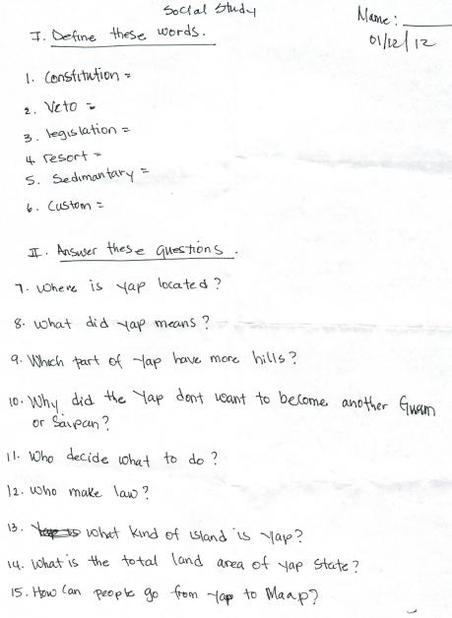 Worksheet found in one of our adopted schools _ When not working, I have been doing a lot of job searching over the past few months looking at what I am going to do post-Pohnpei. Throughout my research I have been astounded at the incredible number of non-profit organizations that exist. There are literally thousands and so many of them are doing the exact same thing. I believe this is the case for many reasons, but I think a main one is because it is exciting and commendable to start something new. While there are obviously many non-profits that do great work, I can’t help but wonder how many of these organizations started off with lots of momentum and slowly faded away when things got tough. It’s easy to start a new program or initiative and to set goals. While most of us have never started a non-profit organization, most of us have set goals, including resolutions a couple months ago. When we share our goals we can make ourselves sound quite accomplished and respectable. As my favorite author Donald Miller brought to my attention, we shouldn’t share our goals. As Miller writes, studies have shown that “when you share a goal publicly, your brain enjoys the sharing in the same way it enjoys the achievement itself, and you’ve lost some of your motivation.” Instead, we should focus on the work rather than any positive publicity from the admirable work we are doing. We should be proud of what we accomplish, not what we say we will accomplish. Ultimately, the strength of MAHI International’s work here in Pohnpei rests on its mission. Specifically with our education program, we are addressing a desperate need. As long as we continue to be blessed with the resources to execute this work, we will continue to persist in our efforts. Like everything on Pohnpei, our progress is slow. In many ways, living in Pohnpei is like living in a different world. It’s not anything new to acknowledge that the modern world is run by instant gratification, with people constantly distracted by the beeps and buzzes of technology. I remember going on a run to Red Square on Georgetown’s campus when I was interning in Washington, DC and stopping for a few minutes to witness how many people were on their cell phone. I ended up staying 20 minutes and literally saw every single person, well over 50 individuals, all talking or texting on their cell phone. It has been challenging to adjust to the slow pace on island, including living without a cell phone. Education reform on any level, anywhere in the world, is incredibly difficult and takes time. The fact that we are seeking to reform the education system on Pohnpei only exacerbates this fact. Despite the ever-present obstacles, I’m learning that only those individuals and organizations that diligently stay the course hold the opportunity to create positive and lasting change.
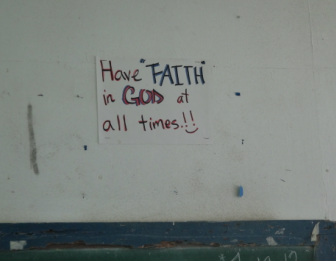 A sign in one of our adopted schools _ One area that has always interested me is the intersection of faith and politics. It interests me so much in fact that I majored in Political Science and Religion. Ever since I declared in these two majors, I have always heard, “Well, that’s an interesting combination.” It’s a long story how I ended up studying these two topics which are touchy alone, but completely explosive when combined. Part of the story involves my affinity to debate. Those who know me know I love to debate (not to be confused with arguing) and I often said throughout college that I was studying the two topics that were the catalyst for the most “spirited conversation.” In retrospect however, I see my studying of politics and religion as a great decision, for two central reasons.
First of all, I learned how to think critically and write. I can’t imagine two skills more essential for success than these. Confronting conflicting theories and paradigms forced me to think for myself, draw my own conclusions and articulate my ideas. Secondly, what I have realized while here in Pohnpei about these two areas is by studying Political Science and Religion, I essentially majored in “Institutional Studies.” As I mentioned in my last post, studying political science involved learning about political institutions and the principles and conduct of government. What is more “institutionalized” in the truest sense of the word than government? There are clearly set rules and regulations with various laws and policies that dramatically impact the citizenry under control of that government. Religion also is encased in institutions, with various faith traditions producing their own rituals, governed by their doctrine, ultimately seeking to influence people’s lives. It’s important to note here that when I say “religion,” I’m referring to the institutionalized framework, such as the Church, rather than an individual’s personal faith journey.
Here’s what I find fascinating – government, in its most basic form, is seeking to organize and establish order in a chaotic world. It does this through creating laws and allotting power to groups and individuals to be held responsible for upholding stability. Religion on the other hand, sees a chaotic world and seeks to establish order through faith in things we cannot see, or rituals which will transcend the mundane of this world and create order in either this world or the next. While most Americans are familiar with the separation of church and state, it’s interesting to note that in a way, the “church and state” (read: religion and government) are seeking to address the same fundamental need.
Some of you are probably wondering, “What does this have to do with Pohnpei?” Well I have found here that there is no separation of church and state whatsoever. First, some background – almost the entire population is Christian and most are “active” in their faith by being involved in a church. Actions outside of Sunday morning for many though provoke questions of how genuine their faith is. I have seen mostly Protestant churches, though there are plenty of Catholic churches revealing the Spanish influence on Pohnpei. My experience so far has showed the churches here to be extremely institutionalized. It has been disheartening as a Christian to see churches feud over petty differences, demonizing their fellow brothers and sisters in Christ, while raising themselves up as “better” than those “other” people. My theory is that because there is such a small population to evangelize that churches become extra competitive, dividing for silly reasons and condemning all those who aren’t part of their church.
Despite the differences between the churches, there are signs of religion everywhere. Examples include Bible verses posted in government offices, prayers being recited before government meetings and everyone saying “Merry Christmas” in December rather than the politically correct “Happy Holidays.” I have also noticed religion’s influence in the schools. The most notable example is when we went to a school and the entire school was going to Catholic mass for the morning. Perhaps I should remind you that we work in public schools. That was a real eye-opener for me. I’ve also witnessed plenty of signs in the schools like the one above, signs you would expect to see in a Christian school.
Given the pervasive nature of religion in Pohnpeian culture, I have come to the conclusion that Pohnpeians are more inclined to look toward religious institutions rather than government institutions to create order. I believe this is the case for multiple reasons. First, the current government isn’t “theirs.” Yes the Federated States of Micronesia have an official Constitution and are a sovereign nation. Their National Constitution details how there are three branches of the government, executive, legislative and judicial, with checks and balances throughout. Each State has its own government while it is also part of the national government as well. Does this sound familiar? Without mixing words, the FSM essentially copied the United States Constitution. Hey, it’s not a bad template, but again, it’s not “theirs.” Something that is “theirs” is the traditional leadership, which still has an extremely large influence, arguably more so than the elected leaders. The Nanwharki (nan-war-kee), i.e. the Chief of each municipality, along with the other respected leaders, have considerable power and represent a critical part of Pohnpeian culture.
Christianity might not be “theirs” either – after all, the locals had their own religion(s) before the white man appeared. This is true, but missionaries arrived more than 30 years before Spain claimed Pohnpei as a colony in the 1880s and overall, Christianity has been adopted as part of Pohnpeian culture. As Pohnpei is a homogenous society I don’t see a particular problem with the amalgamation of religion and government. In America, the melting pot of the world, what I see every day with the influence of religion in government and daily life here in Pohnpei would not be tolerated. For now, witnessing this dynamic in Pohnpei is yet another cultural experience for me.
I know I mentioned at the end of my last post I would discuss the largest obstacle to education reform in Pohnpei. I decided though it’s nice to mix up my posts rather than just post every week about education. So I’m going to hold you in suspense for another week.
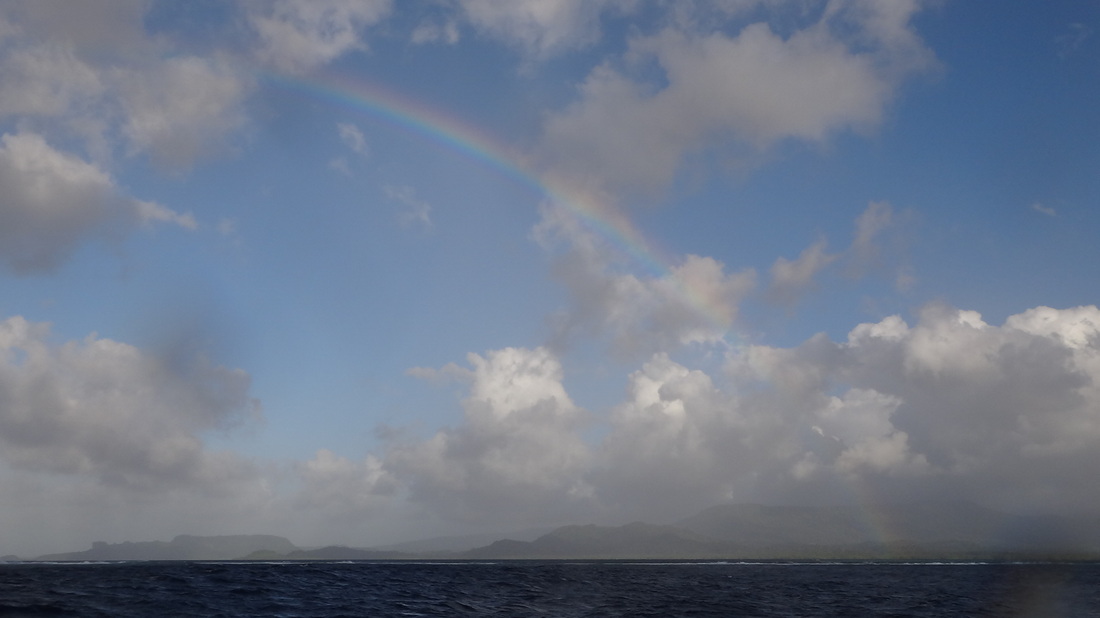 A recent rainbow witnessed on the water off the coast of Pohnpei
 Mr. B teaching at Pohnlangas Elementary School _ When I think of the word “policy” in a government context, I naturally think of government red tape amidst a giant world of bureaucracy that hinders any forward progress. After spending four years in college studying political institutions and the principles and conduct of government, including spending eight months interning in Washington, DC, I have become somewhat jaded and weary of bureaucracy. While this frustration with “the establishment” is understandable, I have been constantly reminded that despite the sometimes perceived barriers bureaucracy can impose, there is a momentous need for strong and sound policy. Without being too brash, many of policies here in Pohnpei just plain stink, which is of little significance as the existing policies are hardly ever enforced. One policy in particular demonstrates the remarkable need for reform. Students here are not taught in English until 4th grade. However, when they enter 4th grade they are handed the same 4th grade Math, Science and English textbooks given to their counterparts who are the same age in America. Unless a child has been raised in an English-speaking household in Pohnpei, which I doubt exists, this student is expected to go from knowing hardly any English to reading at a 4th grade level overnight. It simply makes no logical sense. The argument goes that the locals don’t want to lose their local language by teaching in English beginning in 1st grade. This is an understandable and valid point. I would counter however that in many places throughout the world, students are learning in both their native tongue and English from the beginning of their education, becoming proficient in both languages. Put yourself in the shoes of that 4th grade student handed a 4th grade Science textbook. It might as well be written in hieroglyphics. Progress is made, but at a very slow pace. I have learned the importance of a student’s “instructional reading level.” If a student who is reading at a 1st grade level is handed a 4th grade textbook, he/she is going to become quickly frustrated and discouraged. This inevitably leads to a student not wanting to learn and likely having a negative approach to education for the rest of their life. If that same student is handed a 1st grade level book though, he/she will make progress and move up to the next reading level. This information is critical and explains why we spent two months assessing and compiling each student’s instructional reading level. So from the very beginning, each student is already starting three grades behind. Despite this being a horrible policy, I wish it was enforced. The fact is after traveling to and assessing dozens of 6th, 7th and 8th grade classrooms throughout Pohnpei, I have only witnessed one classroom being taught in English. Even English lessons are being taught in Pohnpeian. When I first discovered the “starting out three years behind” phenomenon, I instinctively thought we should petition for a policy change so students would start being taught in English in 1st grade. After visiting so many classrooms though, with no enforcement of the current policy whatsoever, I realized that would be a gigantic waste of time. Let’s recap: students in Pohnpei don’t start learning in English until 4th grade and are, except in rare circumstances, never actually taught in English, from what I have witnessed through the 8th grade level. I hate to say this, but it gets worse. Much, much worse. I’m going to save for my next post what I believe to be the largest obstacle for education reform in Pohnpei. This is just one policy that matters among many here in Pohnpei. It has become obvious to me throughout this experience that the environment in which a student learns is just as important, if not more so, than a student’s innate abilities and commitment to learning. Just look at that student receiving that 4th grade level textbook. He’s not dumb. He’s a product of a failed system. On a lighter note, this weekend a few of us had a nice short hike up a little mountain that is lovingly called “Chickenshit.” I forgot to mention in my Nan Madol post one legend of how Nan Madol was built. The story goes that chickens carried the large columnar basalt rocks across the island. Apparently, these chicken “relieved themselves” on this part of the island. The little mountain is coned shape, and I can see how the locals could see how it looks like…well, ya know. Pictures below! Lastly, this is my most recent post since my Giants were victorious in Super Bowl XLVI! Here are some glorious highlights of the epic game!
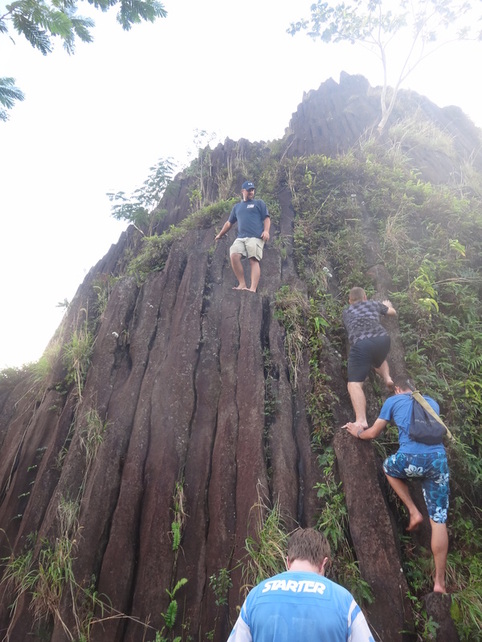 Climbing up Chickenshit. Nope, that wasn't a type-o.  Panorama from atop Chickenshit 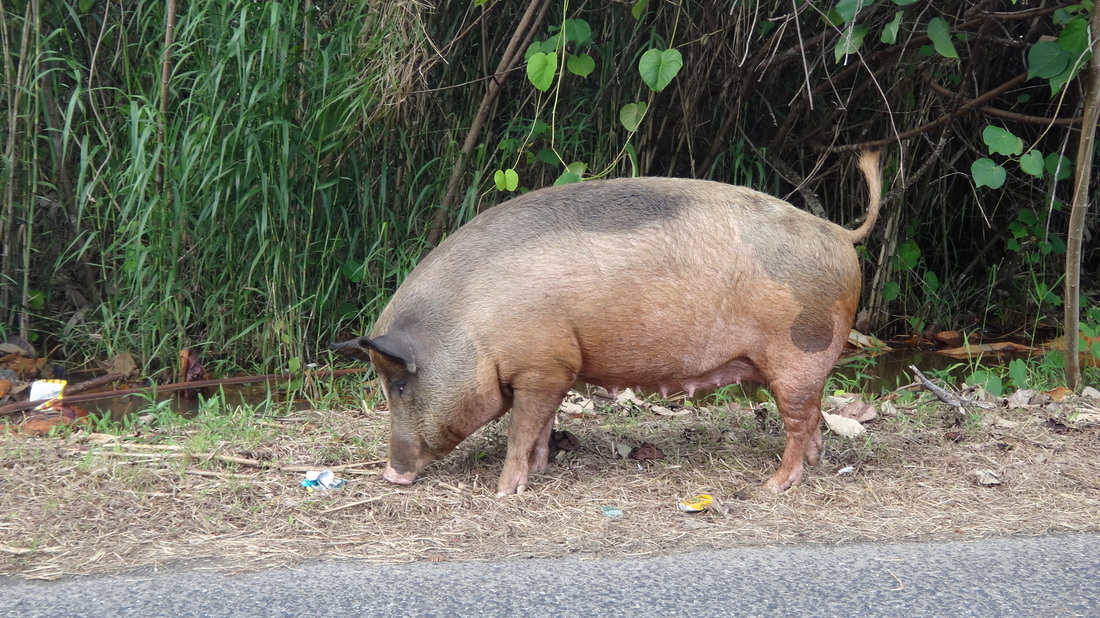 Gigantic pig I saw on the side of the road today in Madolenihmw _
The opinions expressed in this blog are solely those of Drew Robinson.
_ I thought a good post would be to take you through a normal day here in Pohnpei, detailing the work of the MAHI International Education Team. I then quickly realized that there is no such thing as a “normal” day here. This week was a prime example of the erratic Pohnpei schedule. We’re scheduled to go to our adopted schools on Monday, Tuesday and Thursday, with Wednesday and Friday acting as buffer days for inevitable schedule conflicts. If the schedule holds, my Wednesdays and Fridays are spent tutoring students who are really behind, researching and writing grants, and making the necessary preparations for our time in the schools. I also plan to work at the Department of Education to help assist in policy changes to improve the level of education provided throughout Pohnpei. With that information, let’s get into the week! Monday January 30 On Mondays we travel to Pohnlangas Elementary School, the largest and furthest school in our program. Mr. B and I usually leave Kolonia around 9:00 to arrive in time. I was informed early in the morning though that we wouldn’t be leaving until 10:30 as Mr. B had to attend a funeral. I wrote about funerals shortly after I arrived as a major part of Pohnpeian culture. When talking about the funeral dynamic in Pohnpei to friends and family back home, I often get the initial feedback of “Well, it’s a funeral, someone close to them died, of course it’s a big deal.” While this is true for those close to the individual that passed away, the funerals here are more of a large community event than a traditional American funeral. These funerals put families in debt for years and are a large impediment for progress on the island. How, for example, is a local to invest and start a business, if every time he saves up enough money he needs to spend it all, his entire savings, on a funeral? Mr. B wasn’t close to the person that died, but he is an influential member of his community and high-ranking in the traditional leadership on the island and needed to be there. He picked me up and we drove past the funeral. We were running early and stopped by for me to have the cultural experience of visiting a Pohnpeian funeral. My first reaction was being surprised at how many people were there. I haven’t been in groups larger than 20-30 people during my time here, so it felt very odd to be around 150-200 people. Certainly, I will experience reverse culture shock when I travel home! Beyond all the people, it was impressive to witness the massive amount of resources gathered there. I counted over 20 large Sakau plants (which are very difficult to grow) and over 15 pigs. As I have mentioned, pigs are a sign of wealth in Pohnpei and contributing a pig to a funeral is seen as a major sign of respect. Despite my perceived large size of the funeral, Mr. B said it was an average-small funeral. When a very influential member of the community dies the funerals can get truly massive - imagine 60-70 slaughtered pigs! For this funeral though, seeing all the enormous pigs cut in half and children playing with them was most definitely a unique cultural encounter. 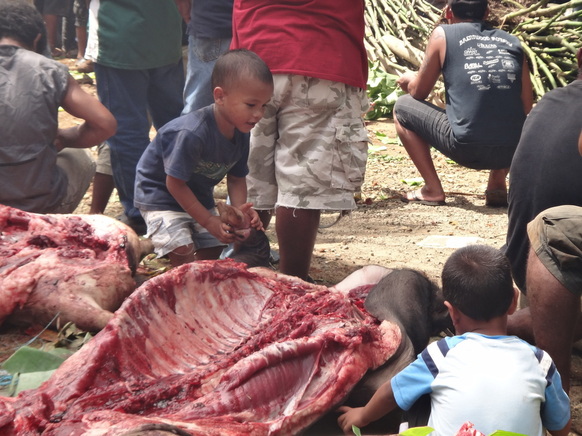 Children playing with a pig at a funeral We continued our drive to Pohnlangas, finishing our 70-minute drive and arriving before lunch was over. We normally teach six classes at Pohnlangas (two for each grade - 6th, 7th and 8th), but combined the classes in each grade to accommodate for our late arrival. I used the Hooked on Phonics program, reviewing the basic letter sounds I previously taught. I then took out the note cards we used to assess all our students during our reading level assessments in October and November. I went through each grade level, correcting mistakes and noting tendencies. I’ll elaborate on my found Pohnpeian tendency in my Tuesday notes (below)! After our three classes, we got back around 4:30 or so and I headed to tutor two children (ages 8 and 11) who recently arrived from Japan. Tuesday January 31 On Tuesdays we work in ESDM Elementary School in the morning and Sapwalap Elementary School in the afternoon. Both of these schools are located in the municipality of Madolenihmw (Med-ole-in-e-um), with ESDM being a 45-minute drive and Sapwalap almost an hour. The normal classroom I use at ESDM was occupied so I had to use the office and adapt to not having a chalkboard. Pen and paper wasn’t as good, but it did the trick. Mr. B and I stopped by a container store on our way to Sapwalap and picked up our normal lunch of nutrition biscuits. They’re nothing amazing, but they get the job done. When we remember/if we have time, we pick up some local food, like below _: 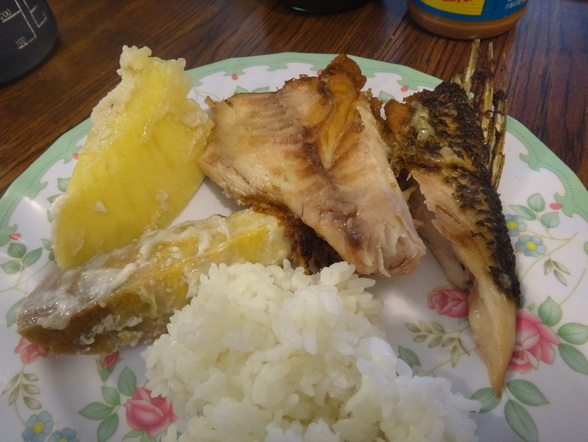 Clockwise: Fried Grouper (a type of reef fish), Rice, Taro, and Mahi (aka Breadfruit) I noticed on Monday in Pohnlangas a specific tendency most Pohnpeians have when speaking English. In fitting with the slow pace of everything on this island, Pohnpeians often speak too slow when pronouncing English words. Two of the most common words in Pohnpeian are spoken ridiculously slow. The word for hello is “Kaselehie” (casa-layyyyyyyyyyy-leeeeeeeee-ahhhhhhhhh). Culturally, the longer it takes to say the more respect you have for the individual(s) you’re addressing. This leads to it sometimes taking literally 5-seconds just to say "hello." The word for thank you is “Kalanghan” (ka-laaaaaaaaaaaaaan-guuun). This slow-speaking tendency translated directly to their speaking of English. When asking the students to say “Certainly” every time they said “sir-taaaaaaaiiinnnnnn-leeee.” Can you see the similarity to “Kalanghan” (ka-laaaaaaaaaaaaaan-guuun)? The students got a kick out of me speaking their Pohnpeian words, but I think they understood how English words are generally spoken more succinctly. Whenever possible, I try to apply whatever I’m teaching to something the students can relate to from what I know about Pohnpei.
Also, I had fun at the schools this week teaching them what "cadence" means. I explained how it's the rhythm in which you speak. I had them drum on tables to understand what rhythm means, and played some rap music (clean rap music, I must note) for them to get an idea of what it means to speak with rhythm and confidence.
Wednesday February 1
It’s February? What? Where did January go? I’m sure I wasn’t the only person that thought this, though being 16 hours ahead of Eastern Standard Time, I likely thought it before you! This week we were still figuring out how I would be using my new-found two “free” days during the week. I spent a large part of the morning researching new ESL teaching methods. I tutored my two Japanese children earlier in the day and spent the rest of the day researching. I expect having a day in the middle of the week away from the schools will be helpful in seeing the greater picture of the issues present in the schools and how we can help. Unrelated to my work was the needed pick-me-up. One of the things I miss most about home is watching sports. As an avid Chris Paul fan, and therefore a new Clippers fan, I likely accounted for at least 20 hits of this epic Blake Griffin dunk:
_ Thursday February 2
On Thursdays we travel to Sekere Elementary School and Sokehs Pah Elementary School (also known as RSP). Both of these schools are in the municipality of Sokehs and are the closest schools, being only 15-20 minutes away. When Mr. B and I arrived at Sekere we found the school completely deserted, save a few kids playing basketball. We asked them if there was school and were informed that there was a teachers meeting all day for all the schools on the island. This is typical Pohnpei - a random teachers meeting in the middle of the week and school being canceled. I guarantee you these students don’t have the US required 180 school days a year. I honestly would be surprised if it was close to 130. We made the plan to do our Sokehs schools the next day.
It really is frustrating to have setbacks like this. I often wonder aloud if we can ever really make an impact in this place, given all the constant obstacles. Despite the frustrations, I took the opportunity to visit the Seventh-Day Adventist School to see my friend Katie, who teaches a student MAHI International mentors. We arranged for me to work with him after school on my two “off” days. I also hoped to obtain more mp3 files the school has on the computer for the rest of the Hooked on Phonics program. The Hooked on Phonics sets that were donated to MAHI International are from 1998 and have the ancient technology of a cassette. I was unable to get the mp3s on Thursday, but made arrangements to get them this coming week. The rest of the day entailed more ESL and grant research and tutoring. Not an expected day, but as you might have gathered, there is no such thing as an “expected” day here.
Friday February 3
I called our Sokehs schools early in the morning to inquire if we could teach that day. I’m told by one principal that many teachers are absent, being sick or attending a funeral. He thought it would be best if we didn’t teach because he wanted the teachers to be there. The other principal said yes (technically, he said "eeeeeeeyyyyy mein" - Pohnpeian for Yes, with the "mein" being for respect, similar to "usted" in Spanish) and we taught there in the afternoon. I spent the morning traveling around with John to various appointments. There are plenty of stories from my time tagging along with John, but I’ll leave those for another time. After teaching in the afternoon I tutored again, where it was nice to evaluate the two children and see their progress from the two weeks I have been working with them.
As you can see, there is no script for a normal Pohnpeian day, or week for that matter. When I woke up Monday I had no idea I would be attending a Pohnpeian funeral, standing in the scorching sun, smelling the sweat of the large group and recently butchered pigs. I didn't plan to use rap music to help teach English, but hey, I needed good examples of cadence in speech! And pulling up to an empty school Thursday wasn't in the game plan. This is just a very small sample among countless examples of a crazy life working on Pohnpei, full of the unexpected. Despite all the obstacles, I love how the days hardly ever blend together. While routine has its benefits, it ultimately makes life go faster – and it’s going fast enough as it is! More than anything, my time here is most definitely teaching me how to adapt and be flexible. Indeed, flexibility is paramount to accomplishing anything on Pohnpei.
So there ya have it. I only have one thing left to say: GO GIANTS!!!
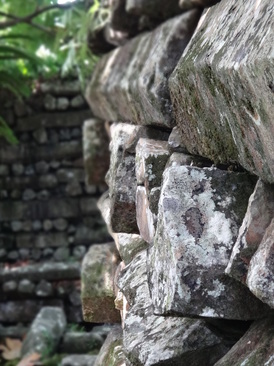 _ One of the first things I read about when researching Pohnpei was Nan Madol. As I noted last week, Nan Madol is the site of an ancient kingdom. The whole complex of Nan Madol is constructed of very large, heavy rocks. Nobody knows how these rocks got there and how this immense rock city was constructed. The first thing I thought of when I was reading about Nan Madol was how it is like the Stonehenge. I then made the large leap to call it the “Stonehenge of the Pacific.” While walking around Nan Madol last Saturday, I became more convinced that my title was fitting. The whole complex is expansive and I only saw a small part of it as you can only navigate the channels within Nan Madol by kayak or paddleboard. I also was shocked at how tall parts of the wall are – I measured one section at easily 25 feet using an old Boy Scout trick. Calling some of these rocks immense is an understatement. I have been told there are rocks over ten tons. All of this brings us to one question: how in the world was this place constructed? No one has an exact date on when this city was inhabited, but the construction dates range from the 8th – 13th century, with inhabitation through the 15th century. However, some carbon dating has shown the construction to have started as early as 200 BC. What makes this even more interesting is that the rock used to build Nan Madol is found on the other side of the island. The Pohnpeian myth is that the ruined city was built by magic. After witnessing the landscape and size of Nan Madol, I can’t blame them for scoffing at the notion this complex was built simply by human strength and ingenuity. Believing in magic and superstition is not uncommon in Pohnpeian culture. While I’m not an expert on local beliefs, I have witnessed several individuals give warnings to heed local tradition. We have been told not to camp on Ahnd (an outer island an hour away from Pohnpei) because it is the home to demons. It was also interesting to be warned not to visit the river behind our house. Apparently, there is an old Pohnpeian lady with white skin and wears a red lava lava (a local dress) who walks along the river at nighttime. I suppose on an isolated island in the vast Pacific Ocean, it’s easy for myths to flourish. As a history buff I’m a fan of learning and knowing as much as we can about the past, but there is something intriguing about the unknown. There are those who will look at Nan Madol and come up with several theories based on science and reason on how this rock city was built. There are others who will let their mind wander, believing structures such as the Stonehenge or Nan Madol must have been built by aliens or some mythic creature. I don’t know where exactly I fall on this spectrum, but I love the debate. The best part: no one will ever definitely know the answer to these mysteries. In between all of the speculation though, I hope we never forget to cherish these beautiful pieces of history and marvel at what can be created when we harness the limitless potential of human (or perhaps alien?) ingenuity. Next post: Education Update! Click here for pictures from hiking up Mt. Kupwuriso (the second highest peak in Pohnpei) two weekends ago, all of the Manta Ray pictures, and the full collection of shots of Nan Madol!
 Some massive rocks making up an exterior wall of Nan Madol
 Hanging out with students at Sokehs Pah Elementary _ This past week we finally jumped into the classroom with both feet, teaching English. We broke the students into two groups, with the lowest performing students working with me on the very basics and the rest being taught by Mr. B. I always try to talk with students after school and during recess to help them practice their English. I ask them things like what they do for fun, what their favorite movie is, and who they know from America. I have some bad news: the number one answer to the latter question is Justin Bieber. The number two answer doesn’t get any better: Miley Cyrus. Despite my disappointment, I had a blast getting to know the kids and it really helps them to practice their English with a native speaker. I should be clear though that the amount of work to be done is immense. This week I taught letter sounds and some very simple vocabulary words. All of this was kindergarten, first and second grade material being taught to 6th, 7th and 8th graders. What I’m stressing to the students and constantly reminding myself though is it doesn’t matter where the students are now – what is of the greatest magnitude is if they make progress and are stronger in their English skills when we leave. I suppose this type of rationalization is necessary when facing a challenge of this size. We are currently waiting to hear back from one of the embassies where we have submitted a grant to receive 15 iPads. MAHI International has also written a grant for 160 iPads – for a total of over $100,000 when adding in the carrying cases and application costs. These will be incredibly helpful educational tools that will pay huge dividends in the classroom. We are currently seeking to get five people like me next year – one volunteer in each of our adopted schools. It has become abundantly clear that we need a native English speaker in each of our schools every day; once a week simply is not enough. I am very confident we’ll make great progress in our schools this year, but having a volunteer in each school every day will produce truly tremendous gains. Below is the description of the position in case you or anyone you know is interested in serving here in beautiful Pohnpei! Outside of work, this past Saturday was one of my favorite days so far here in Micronesia. John, Dale and I woke up at 6:00am to go to Manta Row, to swim with the Manta Rays. It is about a 45-minute boat ride from Kolonia and we needed to get there early when it was at the right tide. I had been there once before, a couple of days before Christmas but it was with a big group and we got there too late, so the current was very strong and most of the Mantas were gone. This time, with just the three of us, we arrived right on time. It was truly incredible. There was a giant school of Rainbow Runners, where the Mantas like to feed on the tiny fish. We stayed close to the Rainbow Runners and the Mantas were right next to us. One time, John grabbed my arm and pointed to my right, and a Manta was literally five feet away. A quick safety disclaimer for those who are wondering, Manta Rays are harmless. It is advised though not to touch them as they have bacteria on them that makes humans sick. Throughout all of this I was excited to capture these incredible creatures on film thanks to my recently arrived underwater camera. I have been told continually that I need to post more pictures, so this pocket camera will literally remain attached at my hip from here on out! Check out the video below to see the Mantas in action! I will just say quickly that no video or image can capture what it’s like to be surrounded by so much life. It can only truly be experienced firsthand! After an hour and a half of swimming with the Mantas we headed back to Kolonia. Dale and I each had a chance to drive the boat which was really fun! We grabbed some food real quick and headed to meet with our friend Kohei, a professional surfer from Japan who recently moved to Pohnpei. He took us, his kids and some friends out to see Nan Madol, the site of an ancient kingdom, made up of these gigantic, extremely heavy rocks. Nobody knows how these rocks got here and how this immense rock city was constructed. I like to call it the “Stonehenge of the Pacific” and have also heard it called the “Atlantis of the Pacific.” It really is an incredible place. Below is a picture of Nan Madol, and I’ll elaborate on the history and structure in an upcoming post. After walking around Nan Madol for a while we hung out on Kohei’s boat fishing and snorkeling. To top the day off, Dale and I went to Joy Restaurant which has the best fried tuna and sashimi I have ever eaten. All in all, an awesome day. (Side note: I'll post all of my recent pictures in my next post!) Just a quick note – my apologies for not posting every Thursday (EST) like I said I would; as you can see I have been very busy! I will do my best though to hold true to my weekly deadline from here on out. Thanks for reading! Volunteer Posting MAHI International is a 501 (c) (3) non-profit organization based in Pohnpei, Federated States of Micronesia, focusing on healthcare, education and leadership development projects throughout Micronesia. Committed to serving the individuals and communities throughout the Pacific Island region, MAHI International’s vision is to increase the quality of life of the people in undeveloped communities. Focusing primarily in Micronesia, MAHI International works largely on improving healthcare and education throughout the islands, while training local Micronesian leaders. For more information, please visit www.mahi-intl.org Position Description MAHI International is looking for English teachers to instruct students throughout public schools on the island of Pohnpei, FSM. Teachers will be placed in one of MAHI International’s adopted schools to focus on improving the reading proficiency of students in grades 6-8. Teachers will also collaborate with school administration, community leaders and parents. The position is for the 2011-2012 school year. No teaching experience is required. Teachers will receive free housing and a living stipend. Qualifications - Fluent English speaker
- 21 + years in age
- Minimum 2 years of college experience
- Hold a US Driver’s License
- Ability to live and work in a remote location within a small community
- Ability to work both independently and as a member of a team
- Excellent communication, social and problem-solving skills
- Willingness to be flexible and adjust to changing circumstances
If interested, please contact Kat Schroer, Program Director at [email protected]
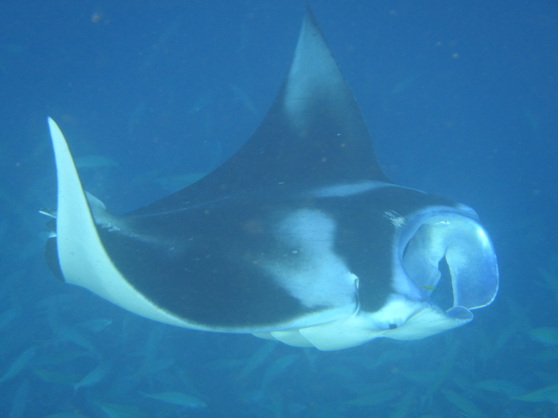 Manta Ray up close  View of our boat while snorkeling with the Mantas 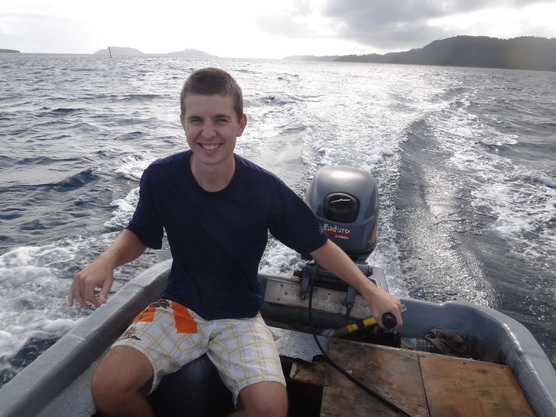 Driving the boat! 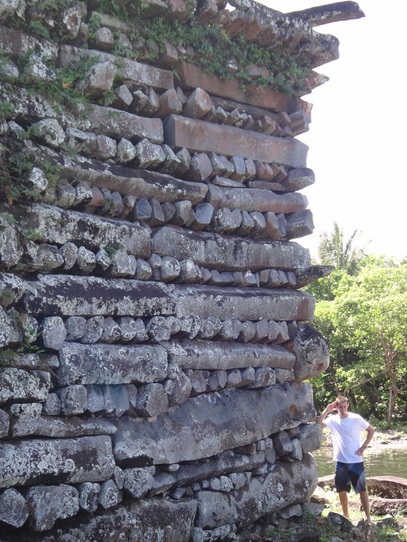 Dale showing the size of a wall at Nan Madol
 _ I had the opportunity last week to visit the Kapinga Village here on Pohnpei to witness local dancing. The Kapinga people are from the island of Kapingamarangi, the southernmost island of Pohnpei State, 740km away. The dances were in celebration of the New Year, a big event here on Pohnpei. For an entire week locals banged on pots, pans, 55 gallon drums – anything. A common scene was having 10-15 people piled in the back of a pick-up truck driving around making plenty of noise. For those not driving around, groups assembled on the side of the road to make a ruckus and spray water on all the cars driving by them. Often, many would be screaming “HAPPY NEW YEAR” or “PARAKUP MWAO” with a blood clenching intensity. It was an interesting cultural encounter to be sure and unlike any New Years I have previously experienced. Below is a video of some Kapinga boys demonstrating proper hula technique. Pardon my giggling, MAHI works with and mentors Nicky (inset) - and this was just too funny! The rest of the pictures can be found here. Overall, the whole event was an eclectic mix of dances and skits. It went from country music ho-downs to hula to toddlers gracefully expressing themselves through dance. On the education front, we visited all our adopted schools this past week, meeting with the principals and setting up our schedule for the rest of the school year. Currently, our plan is to travel to one school each day (five schools for each day of the week), teaching a 30-minute lesson in grades 6, 7, and 8 and staying after school to work with the students who are most in need. Mr. B will be working with the majority of the students while I will be taking the lowest performing 5-10 students per class. MAHI International has been given the generous donation of several Hooked on Phonics programs which I will be using in bringing these kids up to speed. We are hopeful we will receive our iPads within the next month to use them in our program. I have no illusion of how difficult and challenging the task will be to teach students to read who are reading at a first grade, kindergarten or even illiterate level. In the same breath, I can think of few things more worthwhile than teaching a child how to read. I will not be alone in this endeavor as Mr. B will be a guiding hand with his 35+ years of experience in education. It’s incredibly exciting though after all of this time evaluating and assessing to actually have the opportunity make a difference.
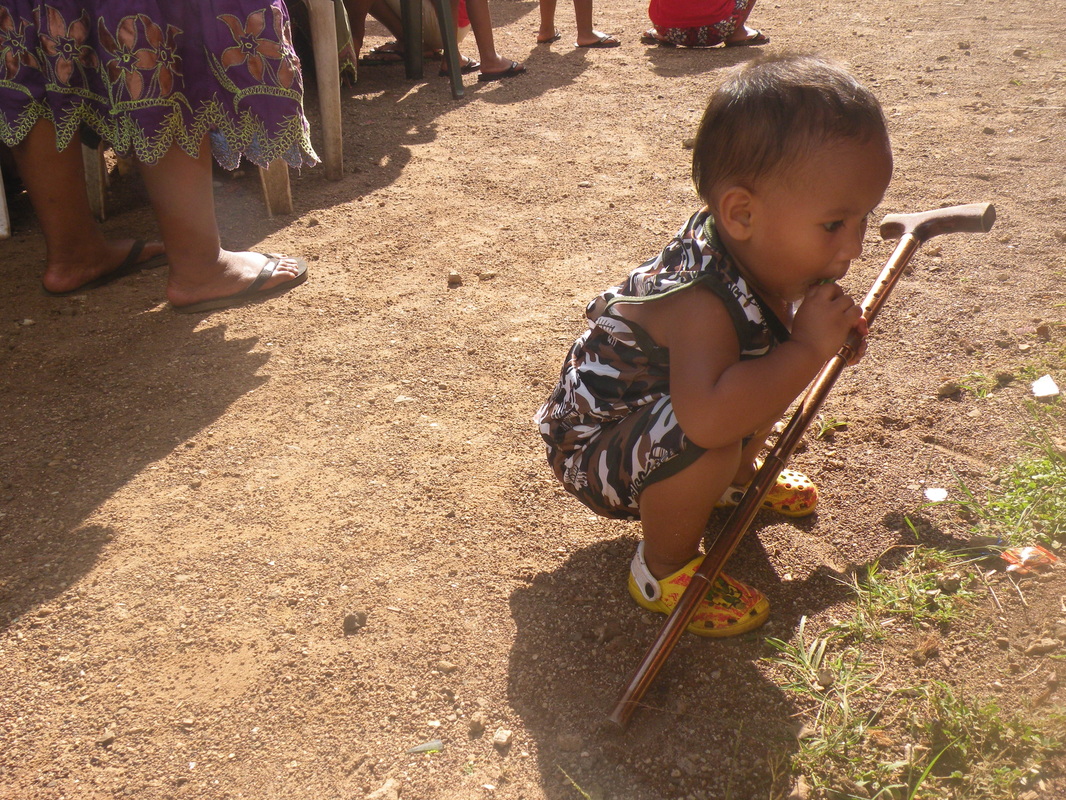 One of my favorite most recent shots entitled "Young to Old"
|























